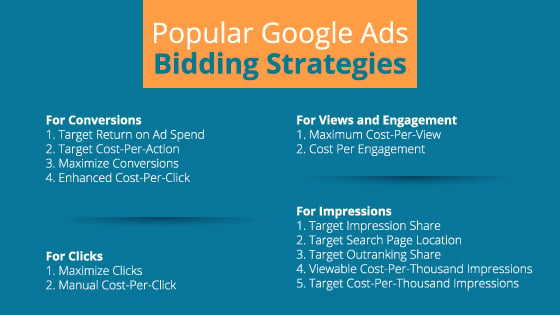
Whether you’re a seasoned bidder or a new advertiser, Google Ads bidding strategies can be a roller coaster of emotions. If you want to know all there is to know about optimizing bids for lead conversions, we've got your back.
Don't Forget to track Your Conversions
If you’re working with any conversion strategy, it is important to remember to use conversion tracking. (You may want to write this down.) You’ll need to enable it before you begin using ad strategies by downloading a tracker for your website. We know the word "tracker" can seem kind of stalkerish, but accurate and complete data is vital to getting the most out of your chosen strategy.
You’ll need to have a reasonable amount of conversion data for Google to give you accurate results. Fifteen conversions over 30 days is the recommended minimum for most strategies, but the more conversions, the more accurately Google will be able to place bids within their display network. The more data you have at the ready, the more likely you are to see a larger profit, and we all love a bigger piece of the pie.
Popular Bidding Strategies
With Google Ads being the largest provider of search advertising on the market and expected to continue growing in 2021, it's time to grab a slice.
There are four Google Ads bidding strategies that work best for conversions. These are target return on ad spend (ROAS), target cost-per-action (CPA), maximize conversions, and enhanced cost-per-click (CPC). If you’re working with conversions, leads, or sales, these are the secret ingredients of bidding strategies.
Target ROAS
Target ROAS is a fully automated bidding strategy that you should use when looking for the highest conversion value rather than the highest number of conversions. With this strategy, Google automatically sets bids to try to gain the highest return. It's like making money with your eyes closed.
To use this bidding strategy, you need to set your maximum spending amount and the percentage of returns you want. Don't worry; this isn't as tricky as it sounds. For example, if you set a 150% return on a campaign you are spending $100 on, you will be making a profit of $50.
The returns will vary from your target. Some may be higher, others may be lower. This strategy is best used for high-budget pay-per-click (PPC) campaigns that can spend a large daily amount on ads like eCommerce.
Target CPA
Target CPA is the strategy best used when you are looking to make more than what it costs to acquire one customer (and we all want more customers!). If you know your CPA, you can use this strategy to set the maximum ad cost to lower than your CPA, thereby making a profit.
This is the optimal bidding strategy for anyone with multiple campaigns as it helps to streamline the bidding process. With this strategy, Google automatically tailors bids to maximize conversions based on a set limit. This strategy also works off of your campaign history data and uses AI to find the best trends and outcomes.
Note: target CPA is a good option only if you have an accurate account of what your CPA is. Individual bids may vary above or below your target, but they should average out, so just go with the flow.
Maximize Conversions
Maximize Conversions is an automated bidding strategy best employed when you have a reasonable amount of campaign data for Google’s AI to work with. When you set your campaign to maximize conversions, Google will automatically optimize bids for the most conversions. With paid advertisements producing an average of 200% return on investment (ROI), you don't want to miss out on the opportunity to maximize conversions.
When you use this strategy, you will have to set a daily budget. This budget tells Google how much you are willing to put into bids and how much you would like on returns. You can also set a maximum and minimum daily amount. There are no specified keywords for this type of bidding.
Once Google has this amount, it will use previous campaign data to tailor bids so that you get the most bang for your buck. This will ensure that you reach the most people you can with the amount you are willing to pay. Don’t waste money showing ads to people who won’t interact with them. We want attention!
Enhanced CPC
Are you still with us? Enhanced CPC is a combination bidding strategy that employs elements of both manual CPC bidding and automatic bidding adjustments. With enhanced CPC, you set your keyword bids manually, and then, per your maximum and minimum limits, Google will automatically adjust your bids for maximized conversions.
This strategy also requires that you have a reasonable amount of campaign data for Google’s AI to work with. It is a good strategy when you are starting a campaign as it will tailor bids more as the campaign progresses and data is collected.
With this strategy, Google can increase or decrease your keyword bids by up to 30%. It does this based on which keywords garner more clicks and conversions. The Google display network reaches over 2 million websites, videos, and apps, so maximum conversion is a great idea if you want all eyes on you.
Other Bidding Strategies
If you’re interested in other Google Ads bidding strategies that don’t focus on conversions (we know you are), there are several types.
Clicks
If you are looking to optimize the number of clicks, the options are:
- Maximize Clicks – Works bid based on a daily budget
- Manual CPC – Setting bids manually for keywords
Views and Engagement
For optimized views and engagement, try these ad strategies:
- Maximum Cost Per View (CPV) – Set with a daily budget for cost per views for videos
- Cost Per Engagement – Best for lightbox ads as it requires a bid for every engagement
Impressions
To garner impressions, there are even more strategies to give the best impression:
- Target Impression Share – Used to outrank competitors in search pages
- Target Search Page Location – Used to rank in the top search results of Google for brand awareness
- Target Outranking Share – Used to outrank specific competitors
- Viewable cost-per-thousand impressions (vCPM) – vCPM bidding sets bids for viewable impressions (per 1000)
- Target CPM – Sets a more specific CPM
Automated vs. Manual Bidding
There are a few fundamental differences between automatic and manual bids, but what it comes down to is time, which we can't ever seem to get enough of.
While manual bidding gives you more control over each aspect and level of bidding, it requires a lot of time to research and optimize bids, keywords, and logistics. Automated bidding offers a much faster and often better performing option for bidding, but takes away some of the personal input aspects.
In short, manual bidding is better for those who are just starting, don’t have many campaigns, have a lot of time and resources to invest, and want total control. Automated bid strategies are better suited to the seasoned advertiser, people with many campaigns or time constraints, and those looking to streamline the bidding process.
Final Thoughts
With these 4 popular bidding strategies, you will be able to optimize any campaign for conversions and make the most profit from your ads. Whether you’re new to Google Ads or a seasoned professional, if your campaign is small or large, there is a conversion strategy for you.
If you want to save time and still receive the same incredible results of a manual bid campaign, reach out to the big dogs like Sparkinator for a free review of your ads account. We’ll help you leverage your market dollars to increase your conversions. Now, who could say no to that deal?






.png?width=1625&name=logo%20(1).png)